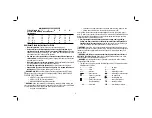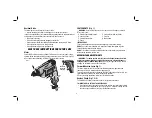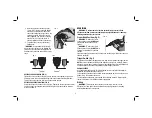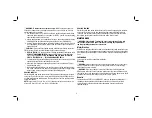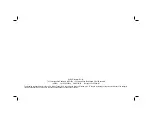
6
WARNING: To reduce the risk of personal injury,
ALWAYS ensure workpiece is
anchored or clamped firmly. If drilling thin material, use a wood “back-up” block to
prevent damage to the material.
1. Use sharp drill bits only. For WOOD, use the low speed setting and twist drill bits,
spade bits, power auger bits, or hole saws. For METAL, use the low speed setting
and steel twist drill bits or hole saws.
2. Always apply pressure in a straight line with the bit. Use enough pressure to keep
drill biting, but do not push hard enough to stall the motor or deflect the bit.
3. Hold tool firmly with both hands to control the twisting action of the drill. If model
is not equipped with side handle, grip drill with one hand on the handle and one
hand on the body.
CAUTION:
Drill may stall if overloaded causing a sudden twist. Always expect the
stall. Grip the drill firmly to control the twisting action and avoid injury.
4.
IF DRILL STALLS
, it is usually because it is being overloaded or improperly used.
RELEASE TRIGGER IMMEDIATELY
, remove drill bit from work, and determine
cause of stalling.
DO NOT CLICK TRIGGER ON AND OFF IN AN ATTEMPT TO
START A STALLED DRILL — THIS CAN DAMAGE THE DRILL
.
5. To minimize stalling or breaking through the material, reduce pressure on drill and
ease the bit through the last fractional part of the hole.
6. Keep the motor running when pulling the bit back out of a drilled hole. This will
help prevent jamming.
7. With variable speed drills there is no need to center punch the point to be drilled.
Use a slow speed to start the hole and accelerate by squeezing the trigger harder
when the hole is deep enough to drill without the bit skipping out.
DRILLING IN METAL
Start drilling with slow speed and increase to full power while applying firm pressure
on the tool. A smooth even flow of metal chips indicates the proper drilling rate. Use
a cutting lubricant when drilling metals. The exceptions are cast iron and brass which
should be drilled dry.
NOTE:
Large [8 mm (5/16") to 13 mm (1/2")] holes in steel can be made easier if a
pilot hole [4 mm (5/32") to 5 mm (3/16")] is drilled first.
DRILLING IN WOOD
Start drilling with slow speed and increase to full power while applying firm pressure
on the tool. Holes in wood can be made with the same twist drills used for metal.
These bits may overheat unless pulled out frequently to clear chips from the flutes.
Work that is apt to splinter should be backed up with a block of wood.
MAINTENANCE
WARNING: Shock Hazard. To reduce the risk of serious personal injury, turn
tool off and disconnect from power source before making any adjustments or
removing/installing attachments or accessories.
Motor Brushes
D
E
WALT uses an advanced brush system which automatically stops the drill when the
brushes wear out. This prevents serious damage to the motor. New brush assemblies
are available at authorized D
E
WALT service centers. Always use identical replacement
parts.
Lubrication
Your power tool requires no additional lubrication.
Cleaning
WARNING:
Blow dirt and dust out of all air vents with clean, dry air at least once
a week. To minimize the risk of eye injury, always wear ANSI Z87.1 approved eye
protection when performing this.
WARNING:
Never use solvents or other harsh chemicals for cleaning the non-
metallic parts of the tool. These chemicals may weaken the plastic materials used in
these parts. Use a cloth dampened only with water and mild soap. Never let any liquid
get inside the tool; never immerse any part of the tool into a liquid.
Repairs
To assure product SAFETY and RELIABILITY, repairs, maintenance and adjustment
(including brush inspection and replacement) should be performed by certified
service centers or other qualified service organizations, always using identical
replacement parts.
Содержание DWDO14S-XE
Страница 1: ...DWDO14S XE VARIABLE SPEED REVERSIBLE DRILL INSTRUCTION MANUAL ...
Страница 2: ......
Страница 10: ...8 ...
Страница 11: ...9 ...





